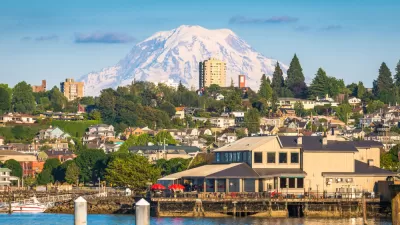As the state toughens rules related to its housing allocation process, cities statewide may finally be forced to overhaul their zoning codes to ensure an adequate supply of housing at all affordability levels.

In a series of somewhat alarmist headlines, writers commenting on California's Regional Housing Needs Assessment proclaim, “A wall of skyscrapers along Ocean Beach? It could happen if S.F. doesn’t stop bungling its planning process” and “Skyscrapers in Davis? Probably Not, but HCD Denial Is Not Nothing.”
To be clear, no one is seriously proposing building high-rises in either of these places. So where do these headlines come from?
The Regional Housing Needs Assessment
Calculated by the state of California every eight years since its inception in 1969, the Regional Housing Needs Assessment (RHNA) dictates how much new housing each city in the state must build at various affordability levels in order to meet its projected housing need. The assessment is agreed upon by the Department of Housing and Community Development (HCD), which uses demographic data and their own formula to calculate housing needs, and each region’s Council of Governments (COG). The COGs are then tasked with distributing the housing needs among their participant jurisdictions. The process is based on the belief that local governments can adopt policies and regulations that promote development and make it easy for private builders to create an adequate supply of housing and is at the heart of California housing policy.
As part of their seven-part general plan, cities are required to provide a housing element that will accommodate the housing units allocated to them. To accomplish this, cities can rezone underused parcels to increase allowable density and implement policies that encourage development. Housing elements are also required to affirmatively further fair housing, a requirement unique to California. Cities are tasked with "taking meaningful actions to" fight discrimination in housing and reduce racial and economic segregation. In past years, many city proposals included unrealistic projections and labeled undevelopable sites as potential housing sites, which the state approved without question. A 2017 Los Angeles Times article asserts that during the last cycle, California only built less than half of the number of homes called for by the RHNA.
How is this cycle different?
During this sixth update cycle, the state scrutinized the plans more closely, rejecting housing elements from several cities as inadequate and sending them back to the drawing board. This is largely due to stricter requirements and larger allocations. For example, the state can now ask cities to reduce site capacity rather than operate under the unrealistic assumption that every developable parcel will be developed.
Southern California, where deadlines to submit housing elements are earlier than in the northern part of the state, saw just seven of 196 housing plans approved right away, with the rest sent back to the cities. Rejections include Los Angeles, Beverly Hills, Santa Monica, and Redondo Beach, which are all required to make revisions before their plans could be approved. According to a tweet from Abundant Housing LA, HCD rejected Beverly Hills’ plan citing “a lack of substantial evidence on the discontinuation of existing uses, an unrealistically high ADU production forecast, & a lack of commitment to constraint removal.” In their response letter to the city, the agency stated that Beverly Hills did not appropriately address their strategy for affirmatively furthering fair housing, did not provide an analysis of environmental and infrastructure constraints that could hinder development on identified sites, and did not identify a timeline for implementing programs to assist low-income households, among other issues. Similarly, HCD raised concerns about Santa Monica’s projections and their weak commitment to fostering inclusivity in single-family zoned neighborhoods.
Observers believe that San Francisco, which was allocated 82,000 units of housing by the RHNA, will likely have to make revisions. In its draft housing element, city officials claim that the city could build the required housing units called for in the next eight years without changing existing zoning, an unrealistic expectation given the slow rate of recent construction and the opposition constantly faced by projects planned for higher-income neighborhoods. An opinion piece by David Broockman and Robert Fruchtman points out that the city would have to build at four times its recent rate to stay on track with housing goals, a speed that can’t happen without major changes in planning and zoning regulations.
In the case of Davis, the state accused the city of not doing enough to promote “fair housing” in its proposed housing element. In their explanation of the rejection of Davis’ housing element, HCD wrote, “The revised element identifies a shortfall of adequate sites to accommodate the regional housing need for lower-income households. It also identifies candidate sites that will be rezoned within the first three years of the planning period.” HCD pointed out other concerns, such as the city’s admission that not enough vacant land is zoned appropriately to meet the city’s housing needs and that a city ordinance that calls for voter approval of zoning changes hinders development of new housing.
Zoning limbo
In addition to losing access to billions in state and federal affordable housing funds, cities have no power to use zoning regulations to reject projects that are 20 percent low-income or 100 percent moderate-income while their housing element is out of compliance. While developers would still have to comply with other regulations such as parking requirements, they would theoretically have more flexibility in height and density.
Without HCD approval, cities are essentially in a state of limbo—they can't use their existing zoning codes or general plans to reject projects. Theoretically, a developer could build an outsized skyscraper anywhere in Davis, Redondo Beach, Beverly Hills or any other city whose housing element has been rejected by HCD. In other words, without an approved housing element, cities cannot regulate density. Further, if applications are filed before the housing element is brought into compliance, cities will be bound by the regulations in place at the time of the application’s filing.
Ultimately, this potential to develop outsized buildings probably won’t become a reality due to the many legal and financial challenges such a proposal would face. Most developers, often dependent on the goodwill of politicians to have their projects approved, have little interest in testing the waters and potentially poisoning the well for future projects. According to an article by David Greenwald, “You would probably need an out-of-town developer with deep pockets (for a lot of reasons) to wade into the risk involved in even proposing such a beast.” But the rejection of housing elements can lead to delays or kill badly needed affordable housing projects. The widespread resistance from cities to state housing mandates points to a larger problem: now that the state is taking its housing crisis more seriously, the effort to develop realistic housing elements that truly address housing needs faces challenges on many fronts as cities cling to the perceived sanctity of local control and NIMBY groups push back on efforts to build more affordable and sustainable neighborhoods.

Maui's Vacation Rental Debate Turns Ugly
Verbal attacks, misinformation campaigns and fistfights plague a high-stakes debate to convert thousands of vacation rentals into long-term housing.

Planetizen Federal Action Tracker
A weekly monitor of how Trump’s orders and actions are impacting planners and planning in America.

Chicago’s Ghost Rails
Just beneath the surface of the modern city lie the remnants of its expansive early 20th-century streetcar system.

Bend, Oregon Zoning Reforms Prioritize Small-Scale Housing
The city altered its zoning code to allow multi-family housing and eliminated parking mandates citywide.

Amtrak Cutting Jobs, Funding to High-Speed Rail
The agency plans to cut 10 percent of its workforce and has confirmed it will not fund new high-speed rail projects.

LA Denies Basic Services to Unhoused Residents
The city has repeatedly failed to respond to requests for trash pickup at encampment sites, and eliminated a program that provided mobile showers and toilets.
Urban Design for Planners 1: Software Tools
This six-course series explores essential urban design concepts using open source software and equips planners with the tools they need to participate fully in the urban design process.
Planning for Universal Design
Learn the tools for implementing Universal Design in planning regulations.
planning NEXT
Appalachian Highlands Housing Partners
Mpact (founded as Rail~Volution)
City of Camden Redevelopment Agency
City of Astoria
City of Portland
City of Laramie






























